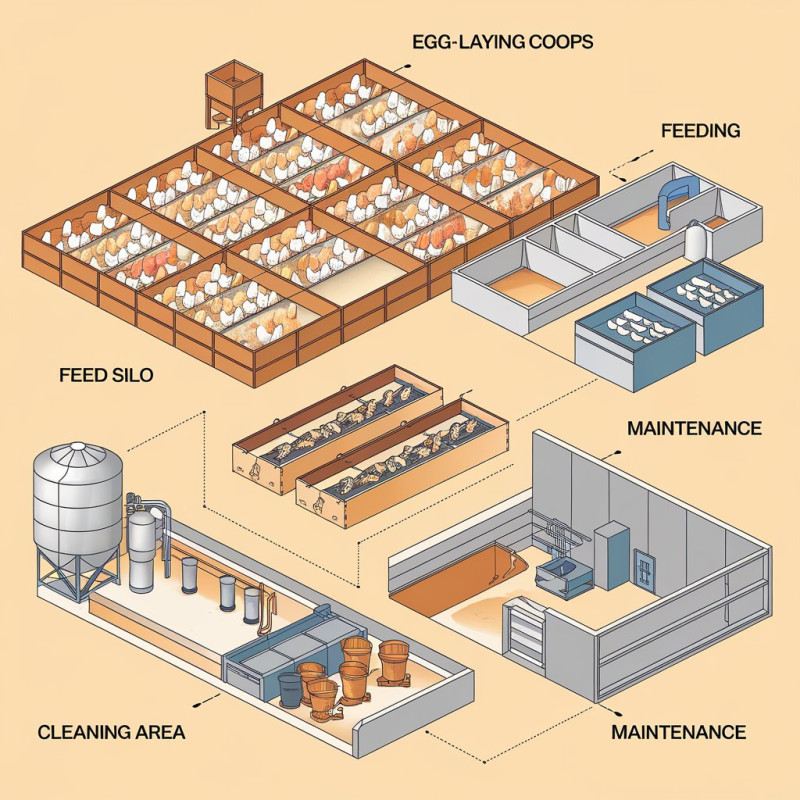How to Set Up Your Poultry Farm for Maximum Productivity
Date : 2024-12-02
Setting up a poultry farm for maximum productivity involves strategic planning, investment in the right equipment, and maintaining the optimal environment for your birds. Whether you're just starting or looking to scale your existing poultry operation, maximizing productivity can significantly improve your profitability. In this guide, we will outline the key steps and best practices for setting up your poultry farm to ensure healthy, productive poultry and a thriving business.
1. Choose the Right Location
The success of your poultry farm begins with selecting the right location. A good location provides access to essential resources such as water, electricity, and feed, while minimizing exposure to adverse weather conditions or contamination risks. When choosing the location for your poultry farm, consider the following factors:
Proximity to Markets: Being close to urban areas or retail buyers will reduce transportation costs.
Water Availability: A reliable water source is essential for the health and hydration of your flock.
Biosecurity Considerations: Set up your farm away from other poultry farms to minimize the risk of disease spread.
2. Invest in Quality Poultry Equipment
Investing in the right poultry farm equipment can greatly enhance productivity and reduce manual labor. High-quality poultry equipment ensures that your farm operates smoothly, with minimal downtime. Key equipment you should consider investing in includes:
Automatic Feeders and Drinkers: These systems ensure that your poultry receive a consistent supply of food and water, reducing waste and ensuring optimal growth.
Brooding Equipment: For newly hatched chicks, the right brooding equipment (such as brooders and heaters) helps to maintain the ideal temperature and humidity levels for the first few weeks.
Egg Collection Trays and Slats: If you're raising layers, egg collection trays and slats can improve egg collection efficiency, reduce breakage, and maintain hygiene.
Waste Management Systems: Effective waste management equipment, like litter cleaning systems, helps maintain a clean environment and reduces the risk of disease.
3. Create an Optimal Environment
Creating a comfortable and healthy environment for your poultry is crucial for maximizing their productivity. Factors like temperature, humidity, and ventilation all affect the growth and health of your birds. Here are some tips to create the ideal environment:
Temperature Control: Ensure that your poultry housing has heating and cooling systems to maintain a constant temperature range that suits the species you're raising.
Proper Ventilation: Good airflow is necessary to reduce moisture buildup and remove excess heat, ammonia, and carbon dioxide.
Lighting: Proper lighting conditions influence egg production and overall bird activity. Using controlled lighting systems can help regulate laying cycles and improve productivity.
4. Implement a Strong Biosecurity Program
Biosecurity is one of the most critical factors in poultry farm productivity. Preventing the spread of diseases ensures that your poultry remain healthy and productive. Here’s how to implement effective biosecurity:
Quarantine New Birds: Before introducing new birds to your farm, quarantine them for a few weeks to prevent the spread of diseases.
Sanitize Equipment and Housing: Regularly disinfect all equipment, tools, and bird housing areas to minimize the chances of bacterial or viral contamination.
Control Access to the Farm: Limit the number of people who enter your farm and require visitors to wear protective gear to prevent contamination.
5. Proper Feeding and Nutrition
Proper nutrition is the backbone of poultry productivity. A well-balanced diet ensures that your birds grow healthy, produce more eggs, and convert feed into weight efficiently. To maximize poultry productivity:
Choose the Right Feed: Work with a nutritionist or poultry feed supplier to create a custom feeding program based on the age, type, and purpose of your poultry.
Provide Clean Water: Access to fresh, clean water is just as important as food in supporting healthy growth and egg production.
Monitor Feed Consumption: Regularly check that all your birds are consuming enough feed and adjust your feeding systems accordingly.
6. Implement Efficient Egg Collection Systems (For Layers)
If you're raising laying hens, an efficient egg collection system is crucial for preventing breakage and maintaining egg quality. Consider:
Automated Egg Collection Systems: These systems gently collect eggs, reducing labor and minimizing breakage.
Proper Egg Storage: Once collected, eggs should be stored in clean, temperature-controlled environments to preserve their freshness.
7. Regular Health Checks and Disease Control
Routine health monitoring and disease control are essential for ensuring the long-term productivity of your farm. Key steps include:
Veterinary Care: Establish a relationship with an experienced veterinarian who can regularly inspect your birds and provide vaccinations or treatments when necessary.
Monitor Bird Behavior: Keep an eye on the behavior and physical condition of your flock to detect early signs of illness.
8. Focus on Record Keeping and Data Analysis
To truly optimize your poultry farm's productivity, maintaining accurate records is essential. Regular data collection helps you make informed decisions regarding your farm’s operations. Track:
Production Rates: Monitor egg production rates, growth rates, and feed conversion ratios.
Health Records: Keep detailed health records for each flock, noting any illnesses, treatments, or vaccinations.
Financial Records: Tracking expenses, feed costs, and income from sales ensures profitability.
9. Sustainable Practices for Long-Term Productivity
Sustainability is becoming an increasingly important factor in poultry farming. By adopting environmentally friendly practices, you can improve farm efficiency and appeal to eco-conscious consumers:
Waste Recycling: Consider composting poultry waste for use as fertilizer or converting it to energy.
Energy Efficiency: Use energy-efficient equipment and renewable energy sources (such as solar power) to reduce energy costs.
Conclusion:
Setting up your poultry farm for maximum productivity requires thoughtful planning, investment in quality equipment, and continuous care for your flock. By creating a comfortable and healthy environment, implementing efficient systems, and maintaining high biosecurity standards, you can optimize your farm’s output and profitability. Don’t forget to monitor farm performance, invest in proper training, and stay up-to-date with the latest poultry farming practices to stay ahead in this competitive industry.